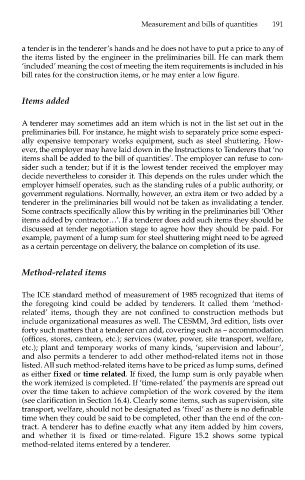Page 211 - Civil Engineering Project Management, Fourth Edition
P. 211
Measurement and bills of quantities
a tender is in the tenderer’s hands and he does not have to put a price to any of
the items listed by the engineer in the preliminaries bill. He can mark them
‘included’ meaning the cost of meeting the item requirements is included in his
bill rates for the construction items, or he may enter a low figure. 191
Items added
A tenderer may sometimes add an item which is not in the list set out in the
preliminaries bill. For instance, he might wish to separately price some especi-
ally expensive temporary works equipment, such as steel shuttering. How-
ever, the employer may have laid down in the Instructions to Tenderers that ‘no
items shall be added to the bill of quantities’. The employer can refuse to con-
sider such a tender; but if it is the lowest tender received the employer may
decide nevertheless to consider it. This depends on the rules under which the
employer himself operates, such as the standing rules of a public authority, or
government regulations. Normally, however, an extra item or two added by a
tenderer in the preliminaries bill would not be taken as invalidating a tender.
Some contracts specifically allow this by writing in the preliminaries bill ‘Other
items added by contractor…’. If a tenderer does add such items they should be
discussed at tender negotiation stage to agree how they should be paid. For
example, payment of a lump sum for steel shuttering might need to be agreed
as a certain percentage on delivery, the balance on completion of its use.
Method-related items
The ICE standard method of measurement of 1985 recognized that items of
the foregoing kind could be added by tenderers. It called them ‘method-
related’ items, though they are not confined to construction methods but
include organizational measures as well. The CESMM, 3rd edition, lists over
forty such matters that a tenderer can add, covering such as – accommodation
(offices, stores, canteen, etc.); services (water, power, site transport, welfare,
etc.); plant and temporary works of many kinds, ‘supervision and labour’,
and also permits a tenderer to add other method-related items not in those
listed. All such method-related items have to be priced as lump sums, defined
as either fixed or time related. If fixed, the lump sum is only payable when
the work itemized is completed. If ‘time-related’ the payments are spread out
over the time taken to achieve completion of the work covered by the item
(see clarification in Section 16.4). Clearly some items, such as supervision, site
transport, welfare, should not be designated as ‘fixed’ as there is no definable
time when they could be said to be completed, other than the end of the con-
tract. A tenderer has to define exactly what any item added by him covers,
and whether it is fixed or time-related. Figure 15.2 shows some typical
method-related items entered by a tenderer.

